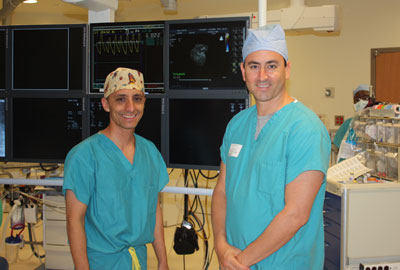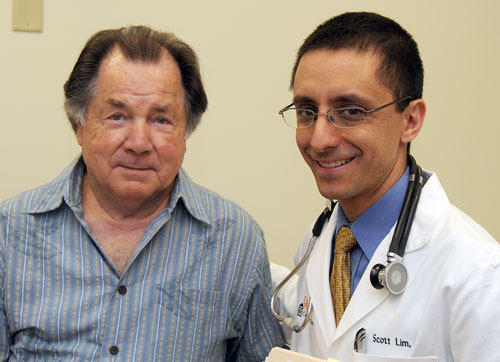MitraClip Gets FDA Approval: 5 Facts You Need To Know
By Adam Pick on November 19, 2013
In case you missed it… The MitraClip just received a Food & Drug Administration (FDA) approval in the United States. This is REALLY big news as the MitraClip is now the first-and-only transcatheter valve therapy for patients with leaking mitral valves, also known as regurgitation. Using the MitraClip, physicians can treat defective mitral leaflets without causing any trauma to the patient’s sternum or ribs. Yep, you read that right. No cracked bones!

To educate our patient community about the significant implications of the MitraClip’s FDA approval, I contacted Dr. Scott Lim, a leading interventional cardiologist at the UVA Advanced Cardiac Valve Center at the University of Virginia. As you might recall, I saw Dr. Lim perform a MitraClip procedure a few years ago. To date, Dr. Lim’s team has performed over 100 MitraClip procedures.
Here are the highlights of my exchange with Dr. Lim:
1. Why is the FDA approval of the MitraClip important for patients to know about?
Dr. Scott Lim: There is thought to be over 4 million Americans struggling with significant mitral valve regurgitation – leakage of the main valve in the heart that directs flow of blood from the lungs to the heart. Every year, there is an additional 1.67 million Americans with new severe mitral regurgitation as well. Despite this, only 2% of them are treated surgically, leaving a large and growing unmet clinical need for another approach to mitral regurgitation. Additionally, for mitral regurgitation that is due to an abnormality of the mitral valve, medicines have not been found to help appropriately treat it. Therefore, doctors and scientists have been looking for a non-surgical but effective way to treat mitral regurgitation, and the MitraClip is the first FDA approved device focusing on repair of a diseased heart valve.

2. Is the MitraClip available to all patients or select groups of patients?
Dr. Scott Lim: In the United States, the FDA approved the MitraClip for patients who have an intrinsic abnormality of their mitral valve (when the valve is abnormal it is called “Degenerative Mitral Regurgitation”), provided the regurgitation is severe, the patient would benefit from the MitraClip procedure, and that the patient is at “prohibitive risk” for open mitral valve surgery. “Prohibitive risk” does not mean that the patient is “inoperable,” but rather at such high risk that open mitral valve surgery is usually not performed.
3. What are the advantages of a MitraClip procedure?
Dr. Scott Lim: The MitraClip procedure is performed through a small incision in the groin, inserting a catheter (or tube) containing the MitraClip into the vein in the leg and advanced up to the part of the heart where leaking mitral valve is. The leaking mitral valve is then repaired by placing one or more MitraClips on the leaking part of the valve. The catheter is then removed and a small bandage is placed over the incision on the leg.
Here is a 3D video animation of the MitraClip procedure described above by Dr. Lim.
The key advantage of the MitraClip procedure is its relative safety compared to open mitral valve surgery. When studied in comparison to open surgery, there was a marked improvement in safety for the patient. Due to the less invasive nature of the MitraClip procedure, patients recover faster – they are discharged from the hospital on average in approximately 3 days – which is less than what occurs for patients undergoing open mitral valve surgery.
4. Are there any unique risks associated with the MitraClip?
Dr. Scott Lim: The most important downside of the MitraClip procedure is likely its efficacy as compared to open mitral valve surgery to reduce the leakage of the mitral valve. Slightly more than 80% of high surgical risk patients undergoing the MitraClip procedure have the mitral regurgitation reduced to a successful point. Also, it is important to remember that this was done only in patients who were thought to have leaking valves that were amenable to repair with the MitraClip in the beginning. Certainly open mitral valve surgery has the ability to repair a much wider range of leaking and primarily abnormal mitral valves.
5. What is your advice for patients (of family members) considering a MitraClip therapy?
Dr. Scott Lim: It is our current understanding that patients who best benefit from the MitraClip therapy are those who are older and higher risk for open mitral valve surgery. A patient who is younger and healthier would likely benefit from open mitral valve surgery where we believe the procedure is more established with a track record of durability, and that a younger patient is better able to tolerate the increased risks of surgery. Older and more frail patients who are less able to tolerate the risks of open surgery due to their co-morbid conditions, are likely the better candidates for the less-invasive, but less effective, MitraClip procedure.

Like heart valve surgery repair, experience of the person performing the procedure is vital. There is a steep learning curve with the MitraClip procedure, and getting advice from a doctor who has done a large number of such procedures will likely be helpful in considering whether the MitraClip procedure will work for a patient. As the MitraClip is a relatively new procedure, there is only a small number of physicians in the US who have such experience (only 2 United States physicians have done more than 150 MitraClip procedures at time of writing this), but hopefully that will change soon with recent FDA approval of the MitraClip.
I hope this helped you learn more about the MitraClip. I know it helped me. That said, many thanks to Dr. Scott Lim for taking the time to educate our community about the recent FDA approval of the MitraClip device that is manufactured by Abbott Vascular. We really appreciate it!
Keep on tickin!
Adam
|
Renata Cimões says on November 22nd, 2013 at 11:34 pm |
|
I am very happy with the advance in the Medicine. |
 |
|
Harikrishana says on April 17th, 2014 at 3:32 pm |
|
Thank you for the information. I would be grateful if you can tell me who has done a large number os this procedures on east coast?? Hari |
 |
|
Harikrishana says on April 17th, 2014 at 3:32 pm |
|
Thank you. |
 |












